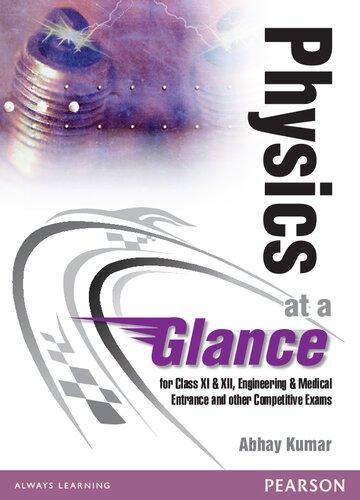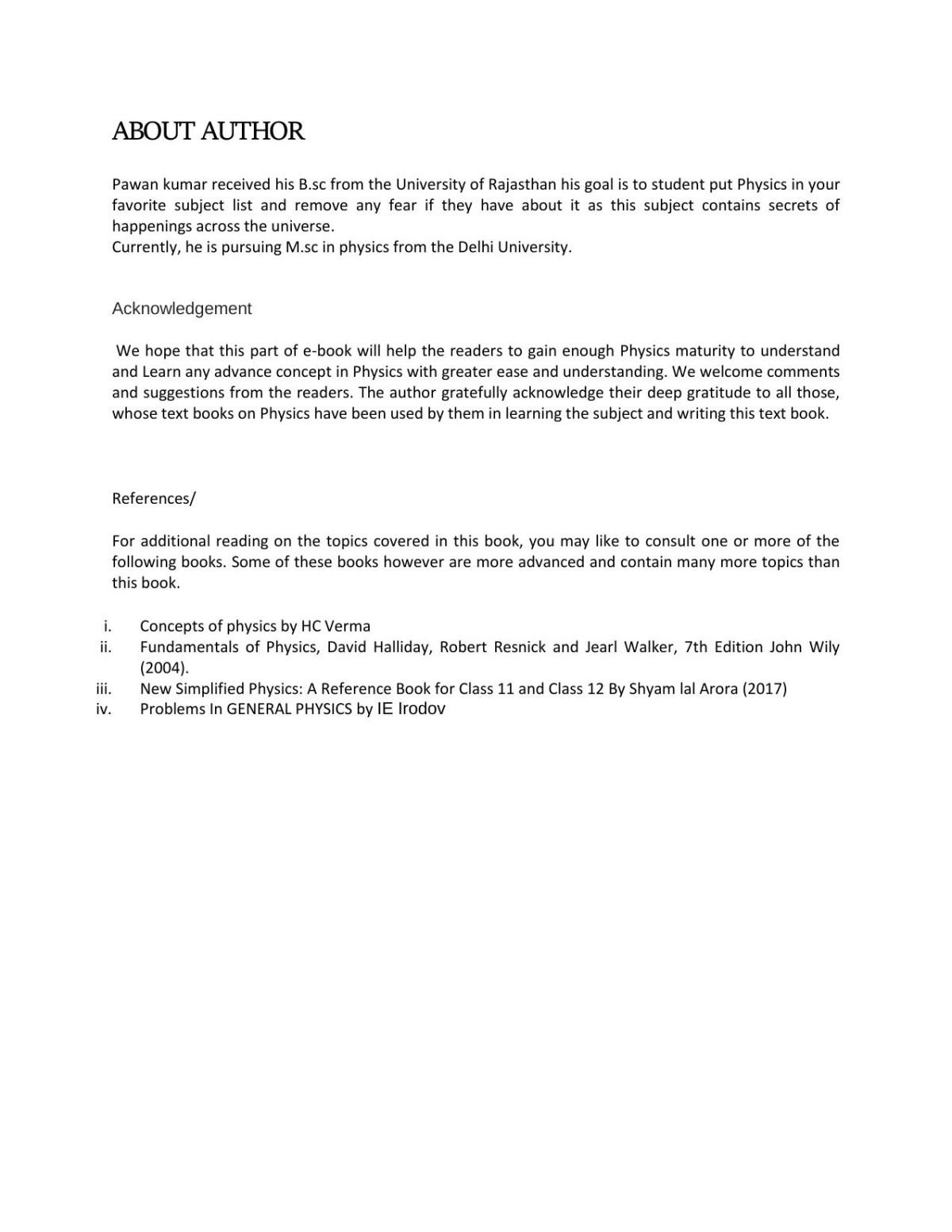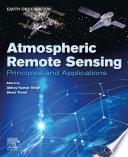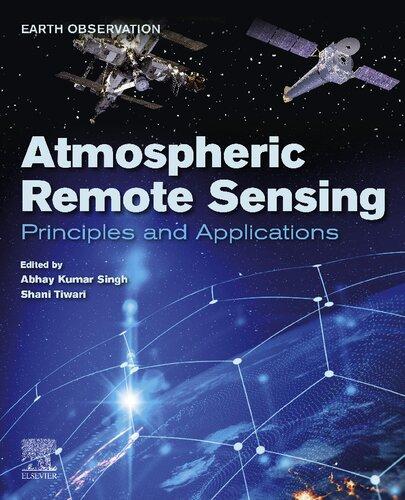Physics at a Glance
Abhay Kumar
Copyright © 2014 Dorling Kindersley (India) Pvt. Ltd.
Licensees of Pearson Education in South Asia
No part of this eBook may be used or reproduced in any manner whatsoever without the publisher’s prior written consent.
This eBook may or may not include all assets that were part of the print version. The publisher reserves the right to remove any material in this eBook at any time.
ISBN 9789332522053
eISBN 9789332537101
Head Office: A-8(A), Sector 62, Knowledge Boulevard, 7th Floor, NOIDA 201 309, India
Registered Office: 11 Community Centre, Panchsheel Park, New Delhi 110 017, India
Dedicatedtomyparents KaushalandPushpa
This page is intentionally left blank.
5.6.2
5.7 Spring 61
5.8 Non-concurrent Coplanar Forces 62
6. WORK, ENERGY, POWER AND CIRCULAR MOTION 63
6.1 Work Done 63
6.1.1 By a Constant Force 63
6.1.2 By a Variable Force 63
6.1.3 By Area Under F-x Graph 63
6.2 Power of a Force 64
6.2.1
6.3
6.3.1
6.3.2
6.3.3 Work-energy Theorem 65
6.3.4 Types of Equilibrium 66
6.3.5 Circular Motion 66
6.3.6 Turning of a Cyclist Around a Corner on the Road 67
6.3.7 A Car Taking a Turn on a Level Road 67
6.3.8
6.3.9
6.3.10
6.3.11
7.1.1
7.1.2 Position of Centre of Mass of Continuous System of
7.1.3 Position of Centre of Mass of More than Two Rigid Bodies 73
7.1.4 Position of Centre of Mass of a Rigid Body from Which Some Portion
8.5.4 Theorem on Moment of Inertia 89
8.5.5 Rolling of a Body on Horizontal Rough Surface 90
8.5.6 Rolling of a Body on Inclined Rough Surface of Inclination q 90
8.5.7 For Rolling with Forward Slipping 91
8.6 Radius of Gyration 95
8.6.1 Couple 96
8.6.2 Conditions for Equilibrium of a Rigid Body 96
9. GRAVITATION
9.1 Properties of Gravitational Force 99
9.1.1 Inertial Mass and Properties of Inertial Mass 100
9.2 Gravitational Mass 100
9.3 Acceleration Due to Gravity 100
9.4 Gravitational Field Strength 101
9.5 Gravitational Potential 102 9.6 Gravitational Potential Energy 103
9.6.1 Relation Between Field Strength E and Potential V 103
10. SOLIDS AND FLUIDS
10.1 Intermolecular Forces 107 10.2 Types of Bonding
10.3 Four States of Matter
10.4 Elasticity
Interatomic Force
(k) 111
10.4.5 Cantilever and Beam 111
10.4.6 Torsion of a Cylinder and Workdone in Twisting 111 10.4.7
10.5.2 Variation of Pressure in a Fluid with the Height from the Bottom of the Fluid 113
10.5.3 Hydrostatic Force Due to Many Liquid Layers 114 10.5.4 Pascal’s Law 114 10.5.5 Archimede’s Principle 115 10.5.6 Variation of Pressure in a Liquid in a Container If the Container Is to Be Accelerated 116
Excess Pressure Due to Surface Tension
10.7.3 Radius of New Bubble When Two Bubbles Coalesce
Radius of Interface
Capillarity
10.7.6 Zurin’s Law
10.7.7 Poiseuille’s Formula and Liquid Resistance 121 10.7.8 Stoke’s Law and Terminal Velocity 122 10.7.9 Reynold’s Number 123 10.7.10 Bernouilli’s Theorem
10.7.11 Torricelli’s Theorem 124
11. OSCILLATIONS AND WAVES (ACOUSTICS)
11.1 Different Equations in SHM 126
11.2 Graphs Related to SHM 127
11.2.1 Spring Block System 128
11.2.2 Pendulum 130
11.2.3 Physical Pendulum 130
11.3 Some Other Important Points Concerning SHM 130
11.3.1 Wave Equation 132
13.1.2
12.3.1 Entropy
15.
CAPACITORS
15.1 Capacitance 170
15.2 Isolated Conductor 170
15.3 Parallel Plate Capacitor 171
15.4 Spherical Capacitor 174
15.5 Cylindrical Capacitor 174
15.6 Combination of Capacitors 174
15.7 Dielectrics 175
15.7.1 Polarization of Dielectric Medium Placed in an Electric Field 175
16. OHM’S LAW, THERMAL AND CHEMICAL EFFECT OF ELECTRICITY 177
16.1 Electric Current 177
16.1.1 Series Combination 178
16.1.2 Parallel Combination 178
16.2 Resistance of a Conductor 179
16.2.1 Variation of Resistivity 179
16.3 Ohm’s Law: V = IR 180
16.4 How to Find Equivalent Resistance 181
16.4.1 Successive Reduction Method 181
16.4.2 Using Symmetry of the Circuit 184
16.4.3 Using Star-delta Conversion Method 189
16.4.4 Using Infinite Ladder Method 191
16.5 Colour Code for Carbon Resistors 194
16.5.1 Superconductivity 195 16.5.2 Potentiometer 195
16.6 Study About R–C Circuit 196
R–C Discharging Circuit 199
17. MAGNETIC EFFECT OF CURRENT AND
17.1 Magnetic Field Produced by Moving Charge or Current 203
Magnetic Force on a Moving Charge in Uniform Magnetic Field 203
Path of a Charged Particle in Uniform Magnetic Field
List of Formulae in Uniform Circular Motion
To Find Velocity and Position at Time t
Magnetic Force on a Current Carrying Wire in a Uniform Magnetic Field
Magnetic Force on a Curved Wire in Uniform B 206 17.8 Torque on a Current Carrying Coil Placed Inside a Magnetic Field 207
17.9 Magnetic Field at a Point Due to a Current or System of Current 208 17.10 List of Formulae 209
Ampere’s Circuital Law (ACL)
Magnet and Its Characteristics
17.13 Properties of a Magnet 214
17.14 Magnetic Lines of Force and Their Characteristics 216
17.14.1 Intensity of Magnetization 218
17.14.2 Magnetic Permeability 218
17.14.3 Magnetic Susceptibility 218
17.15 Earth’s Magnetism 219 18. ELECTROMAGNETIC INDUCTION AND ALTERNATING CURRENT 222
18.1 Magnetic Flux 222
18.1.1 Faraday and Lenz Law (I from B) 222
18.1.2 Lenz’s Law 223
18.2 Mechanism of Electromagnetic Induction Across a Conductor 223
18.3 How to Solve Problems Related to Motional EMF 225
18.3.1 Self-inductance 226
18.3.2 Mutual Inductance (M) 227
18.3.3 Inductor (Solenoid and Toroid) 227
18.3.4 Current Growth in L–R Circuit 228
18.3.5 Current Decay in L–R Circuit 229
18.3.6 LC-oscillatory Circuit 229
18.3.7 Alternating Current (AC) 231
18.3.8 Choke Coil 234
18.3.9 Transformer 234
19.1 Conduction Current 236
19.2 Displacement Current
19.3.1 Maxwell’s Equations
19.4 Electromagnetic Waves 237 19.5 Electromagnetic Spectrum 238
19.5.1 Radiowaves (Frequency Range: 500 kHz to About 1000 MHz) 238
19.5.2 Microwaves (Frequency Range: 1 GHz to 100 GHz) 238
19.5.3 Infrared (IR) Waves (Frequency Range: 1011 Hz to 5 × 1014 Hz) 238
19.5.4 Visible Light (Frequency Range: 4 × 1014 Hz to About 7 × 1014 Hz) 239
19.5.5 Ultraviolet (UV) Radiation (Frequency Range: 1014 Hz to 1017 Hz) 239
19.5.6 X-rays (Frequency Range: 1017 Hz to 1019 Hz) 239
19.5.7 Gamma Rays (Frequency Range: 1018 Hz to 1022 Hz) 239
Division of Wavefront
Division of Amplitude
Young’s Double Slit Experiment
19.9 Diffraction of Light
19.9.1 Fraunhofer Diffraction Due to a Single Slit
19.9.2 Fraunhofer Diffraction at a Circular Aperture
20. RAY OPTICS AND OPTICAL INSTRUMENTS
20.1 Reflection of Light 250
20.2 Characteristics of Image Due to Reflection by a Plane Mirror 250
20.2.1 Effect of Rotation of Plane Mirror on the Image 251
20.2.2 Number of Images Formed by Two Inclined Plane Mirrors 252
20.2.3 Concept of Velocity of Image in the Plane Mirror 254
20.3 Curved Mirrors 255
20.3.1 Concept of Velocity of Image in Spherical Mirrors 258
20.4 Refraction of Light 259
20.5 Laws of Refraction 259
20.5.1 Refraction at Plane Surface 260
20.5.2 Total Internal Reflection 260
20.5.3 Refractive Index (R.I.) and Critical Angle 260
20.5.4 Spherical Refracting Surfaces 261
20.5.5 Refraction from Spherical Surface 262
20.6 Lens 262
20.6.1 Lens Maker’s Formula 262
20.6.2 Nature of Image Formation by Convex Lens and Concave Lens 263
20.6.3 Concept of Velocity of Image in the Refraction Through Spherical Surface and Plane Surface 265
20.6.4 Concept of Velocity of Image in the Refraction Through Lens 265
20.7 Power of the Lens 267
20.7.1 Combinations of the Lenses 267
20.8 Prism 270
20.9 Defects of Vision of Human Eye 270
20.9.1 Simple Microscope 271
20.9.2 Compound Microscope 271
20.9.3 Astronomical Telescope 272
20.9.4 Terrestrial Telescope 272
21. ATOMS AND NUCLEI 273
21.1 Atoms 273
21.1.1 Dalton’s Atomic Theory 273
21.1.2 Thomson’s Atomic Model 273
21.1.3 Rutherford’s Atomic Model 273
21.1.4 Impact Parameter and Angle of Scattering 274
21.1.5 Bohr’s Atomic Model 275
21.1.6 Bohr’s Formulae 276
21.1.7 Hydrogen Spectrum 277
21.1.8 Kossel Diagram 278
21.1.9 Energy Level Diagram of Hydrogen Atom 279
21.1.10 Wave Model 280
21.1.11 Work Function 280
21.1.12 Electron Emission 281
21.1.13 Photoelectric Effect 281
21.1.14 Properties of Photon 282
21.2 Matter Wave or de Broglie Wave or Wavelength 283
21.3 X-rays 284
21.3.1 Mosley’s Law 284
21.3.2 Isotopes 284
21.3.3 Isobars 285
21.3.4 Isotones 285
21.3.5 Isomers 285
21.3.6 Mass Defect (Δm) 285
21.3.7 Binding Energy (ΔE) 285
22.4
22.5
22.6
Mathematical Tools
1.1 TRIGONOMETRY
The branch of mathematics which deals with measurement of sides and angle of triangle is called trigonometry. There are two methods for measuring angles of triangle.
1. Degree method:
1(rt. ∠) = 90°, 1° = 60′ (min), 1′ = 60″ (sec)
2. Radian method:
(a) p radians = 180°
(b) An arc of length l makes angle q o at the centre of circle whose radius is r, then
3. Degree measure = 180 π × Radian measure
4. Radian measure = 180 π × Degree measure
5. sin2q + cos2q = 1, sin2q = 1 cos2q, cos2q = 1 sin2q
q 1
cosec2q cot2q = 1, cosec2q = 1 + cot2q, cot2q = cosec2q 1 8. tan q = sin cos θ θ , cot q = cos sin θ θ 9. sin q ⋅ cosec q = 1, tan q ⋅ cot q = 1, cos q ⋅ sec q = 1
Table 1.1 Sign of T-function
Quadrant1st2nd3rd4th
sin, cosec ++−−
cos, sec +−−+
tan, cot +−+−
1.1.1 Formulae for Compound Angle
1. sin (A + B) = sin A cos B + cos A sin B
2. sin (AB) = sin A cos B cos A sin B
3. cos (A + B) = cos A ⋅ cos B sin A ⋅ sin B
4. cos (AB) = cos A ⋅ cos B + sin A ⋅ sin B
5. tan (A + B) = + −⋅ tantan 1tantan AB AB
6. tan (AB) = +⋅ tantan 1tantan AB AB
1.1.2 Transformational Formula
1. 2 sin A ⋅ cos B = sin (A + B) + sin (AB)
2. 2 cos A ⋅ sin B = sin (A + B) sin (AB)
3. 2 cos A ⋅ cos B = cos (A + B) + cos (AB)
4. 2 sin A ⋅ sin B = cos (AB) cos (A + B)
5. sin C + sin D = 2 sin +− ⋅ cos 22 CDCD
7. cot (A + B) = ⋅− + cotcot1 cotcot AB AB
8. cot (AB) = ⋅+ cotcot1 cotcot AB BA
9. sin (A + B) ⋅ sin (AB) = sin2A sin2 B
10. cos (A + B) cos (AB) = cos2A sin2B
6. sin C sin D = 2 cos +− ⋅ sin 22 CDCD
7. cos C + cos D = 2 cos +− ⋅ cos 22 CDCD
8. cos C cos D = 2 sin +− sin 22 CDDC
1.1.3 Formulae for Multiple and Sub-multiple Angles
1. sin 2A = 2 sin A cos A = + 2 2tan 1tan A A
2. cos 2A = cos2A sin2 = + 2 2 1tan 1tan A A A
3. tan 2A = 2 2tan 1tan A A
4. sin 3A = 3 sin A 4 sin3A
5. cos 3A = 4 cos3A 3 cos A
6. = 3 2 3tantan tan3 13tan AA A A
9. tan A = 2 2tan 2 1tan 2 A A 10. 1cos 1cos A A + = tan2 2 A (II) sin (+ve) (I) all (+ve) (III) tan (+ve) (IV) cos (+ve)
7. sin A = 2 sin 2 A cos 2 A = 2 2tan 2 1tan 2 A A + 8. cos A = cos2 2 A sin2 2 A = 2 2 1tan 2 1tan 2 A A +
Notes
sin 18° = 51 4
sin 36° = 1026 4
1.1.4
cos 18° = + 1025 4
cos 36° = 51 4 +
Trigonometric Equations
The equation which contain trigonometric function is called T-Equation, e.g., cos x = 2 sin x
1. If sin x = 0 ⇒ x = np
2. If cos x = 0 ⇒ x = (2n + 1) 2 π
3. If tan x = 0 ⇒ x = np
4. If sin x = ± 1 ⇒ x = (4n ± 1) 2 π
5. If cos x = 1 ⇒ x = 2np
6. If cos x = 1 ⇒ x = (2n + 1)p
7. If sin x = sin y ⇒ x = np + ( 1)ny
8. If cos x = cos y ⇒ x = 2np ± y
9. If tan x = tan y ⇒ x = np + y
10. If sin2 x = sin2y ⇒ x = np ± y
11. If cos2 x = cos2 y ⇒ x = np ± y
12. If tan2 x = tan2y ⇒ x = np ± y where n = 0, ± 1, ± 2, ± 3, .....
Table 1.2
Some Trigonometrical Values
( q )(90° q )(90° + q )(180° q )(180° + q ) sin sinq cosq cosq sinq sinq cos cosq sinq sinq cosq cosq tan tanq cotq cotq tanq tanq cot cotq tanq tanq cotq cotq sec secq cosecq cosecq secq secq cosec cosecq secq secq cosecq cosecq
1.1.5 Value
of (2p ± q)
1. sin (2p + q) = sin q
2. cos (2p + q) = cos q
sin (2p q) = sin q
cos (2p q) = cos q
3. tan (2p + q) = tan q tan(2p − q) = tan q
4. cot (2p + q) = cot q
5. sec (2p + q) = sec q
6. cosec (2p + q) = cosec q
cot (2p q) = cot q
sec (2p q) = sec q
cosec (2p q) = cosec q
1.1.6 Value
3 sin cos, 2 π ⎛⎞θθ
2. 3 sin cos, 2 π ⎛⎞θθ
Table 1.3 Value of Some Standard Angles
Note: ∞ means undefined.
1.1.7 Inverse Trigonometric Functions
The value of inverse T-functions lies between the given range.
sin 1x, x ∈ , 22 ππ ⎡⎤ ⎢⎥ ⎣⎦ cot 1x, x ∈ (0, p)
cos 1x, x ∈ [0, p] sec 1x, x ∈ [0, p] 2 π ⎛⎞ ⎜⎟ ⎝⎠
tan 1x, x ∈ , 22 ππ ⎛⎞ ⎜⎟ ⎝⎠ cosec 1x, x ∈ , 22 ππ ⎡⎤ ⎢⎥
1. sin 1x + cos 1x = 2 π ( 1 ≤ x ≤ 1)
2. tan 1x + cot 1x = 2 π , x ∈ R 3. sec 1x + cosec 1x = 2 π x ≥ 1 4. sin x = cosec 1 1 x , x ≤ 1
5. cos 1x = sec 1 1 x , x ≤ 1
6. tan 1x = cot 1 1 x , ∞ < x < ∞
7. sin 1 ( x) = sin 1x
8. cos 1 ( x) = p cos 1x
15. sin 1x ± sin 1y = sin 1 () 1122 xyyx −±−
16. cos 1x ± cos 1y = cos 1 () 1122 xyxy ∓
17. tan 1x ± tan 1y = tan 1 1 xy xy ± ⎛⎞
18. 2 tan 1x = tan 1 2 2 1 x x
19. 2 cos 1x = cos 1(2x2 1)
9. tan 1 ( x) = tan 1x
10. cot 1 ( x) = p cot 1x
11. sec 1 ( x) = p sec 1x
12. cosec 1 ( x) = cosec 1x
13. y = sin 1x ⇒ x = sin y
14. x = sin y ⇒ y = sin 1x
20. 3 sin 1x = sin 1(3x 4x3) 21. 3 cos 1x = cos 1(4x3 3x) 22. 3 tan 1x = tan 1 3 2 3 13 xx x ⎛⎞
1.2.1 Quadratic Equation
An equation of the form ax2 + bx + c = 0, where a, b, c are certain numbers and a ≠ 0, is called a quadratic equation.
1. Discriminant of a quadratic equation: The numbers (b2 4ac) is called discriminant of the quadratic equation ax2 + bx + c = 0 and is denoted by D. i.e., D = b2 4ac.
2. Nature of roots of the quadratic equation: The value of x which satisfy the equation ax2 + bx + c = 0 are called roots of the equation. The roots a and b of the equation ax2 + bx + c = 0 are given by, −−−−−−+−−+ === 2244 , 2222 bbacbDbbacbD aaaa β
Now there are three possibilities :
Case I: When D < 0, i.e., b2 4ac < 0. In this case D will be imaginary, hence a and b will be both imaginary.
Case II: When D = 0, i.e., b2 4ac = 0. In this case D = 0, from the above equation, a = , 2 b a b = 2 b a . Hence both roots a and b will be real and equal.
Case III: When D > 0, i.e., b2 4ac > 0. Then the roots a and b will be real and different (distinct).
1.2.2 Determinants
Let a, b, c, d be any four numbers, the symbol ab cd denotes adbc and is called a determinant of second order. The elements of a determinant are multiplied diagonally, like, ab cd = adbc
For example, 24 32 = 4 12 = 8
The elements which lie in the same horizontal line constitute one row and the elements which lie in the same vertical line constitute one column.
Row1 Row2 ab
Column 1 Column 2
1.2.3 Determinant of Third Order
The determinant of 3rd order has three rows and three columns.
the expansion of the determinant along its first row will be
1.2.4 Progression
If the terms of a sequence are written under specific conditions, then the sequence is called progression. Here we shall study only two types of progressions.
Arithmetic Progression (A.P.)
An arithmetic progression is a sequence of numbers such that the difference between any two successive terms is a constant called common difference.
Examples
1. 1, 4, 7, 10, 13 … are in A.P., whose first term is 1 and common difference (c.d.) is 3.
2. The sequence of numbers 10, 8, 6, 2, 0, 2, 4, … are in A.P., whose first term is 10 and c.d. = 2.
In general, an A.P. is expressed as, a1, a2, a3 an, and the common difference is defined as d = a2 a1 =
Properties
1. The nth term of an A.P. is given by, an = a1 + (n 1)d.
2. The sum of the first n terms of an A.P. is given by
1.2.5 Geometric Progression
A geometric progression is a sequence of numbers such that the ratio of each terms to the immediately preceeding one is a constant called the common ratio.
Examples
1. The numbers 2, 4, 8, 16, 32, 64 … form a G.P. with common ratio = 2.
2. The numbers 1, 0.1, 0.01, 0.001, … constitute a G.P. with ratio 0.1. In general, a G.P. is expressed as, a1, a2, a3, … an; and the common ratio is defined as
Properties
1. The nth term of G.P. is given by an =
1; where a1 is the first term and r is the common ratio.
2. The sum of first n terms of G.P. is given by
when (r < 1)
The sum of infinite terms of G.P. for r < 1 is given by
1.2.6 Some Important Summation of Series
1. The sum of the first n natural number Sn = 1 + 2 + 3 + ……… + n = (1) 2 nn +
2. The sum of the squares of the first n natural numbers i.e., Sn2 = 12 + 22 + 32 + + n2 = (1)(21) 6 nnn++
3. The sum of the cubes of the first n natural numbers
n3 = 13 + 23 + 33 + ……… + n3 = 2 (1) 2 nn + ⎡⎤
1.2.7 Binomial Theorem for Any Index (1 + x)2 = 1 + 2x + x2 (1 + x)3 = 1 + 3x + 3x2 + x3
1. (1 + x)n = 1 + nx ++++ … (1)(1)(2)23 , 2!3! nnnnnn xxx where n is a +ve integer.
Number of terms in (1 + x)n is n + 1.
Meaning of factorial 2!
2. But if n is a ve integer or positive or negative fraction; then (1 + x)n = 1 + nx + (1)(1)(2)23 2!3! nnnnn xx++∞ …
Provided x < i.e., 1 < x < 1
Number of terms in this case will be infinite.
1.2.8 Exponential and Logarithmic Series
1. 111 1to , 1!2!3! e =++++∞ ……… which is 2.71828 …… is read as exponential number.
2. 23 1to , 1!2!3! xxxx e =++++∞ where x is any number.
3. 23 1to , 1!2!3! xxxx e =−+−+∞ ……… where x is any number.
4. loge (1 + x) = −+−+∞−≤≤ …… 234 to (11) 234 xxx xx
5. loge (1 x) = −−−−−∞−≤≤ 234 to (11) 234 xxx xx
1.3 CALCULUS
1.3.1 Limits
Let us consider the function y = f (x) = 2 4 . 3 x x
If we put x = 3, we have y =
94
33 = 5 0 = ∞ , which is meaningless. It means that the function is not defined at x = 3. But still, we want to know the value of the function at a value slightly smaller or greater than 3. If we could define the function at a value slightly smaller or greater than 3, then we say that the limit of function exists as x approaches 3. In mathematics it is represented by the symbol 3 lim x →
The expected value of the function f (x) to the left of a point x = a is called left hand limit. It is denoted by lim(). xa fx →
The expected value of function f (x) to the right of a point x = a is called right hand limit is denoted by lim(). xa fx + →
The limit of a function f (x) at point x = a is the common value of left and right hand limit. It is denoted by lim() xa fx →
A variable whose limit is zero is termed as infinitely small quantity (infinitesimal). Mathematically, it may be written as x → 0. A variable that constantly increases in absolute magnitude is termed as infinitely large quantity. Although infinitely large quantities do not have any limits but it is conventional to say that an infinitely large quantity ‘tends to an infinite limit’. The symbol → reads as ‘tends to’.
1.3.2 Basic Formulae of Limit
If f(x) and g(x) are two function then,
1. {} lim()()lim()lim() xaxaxa fxgxfxgx →→ → +=+
2. {} lim()()lim()lim() xaxaxa fxgxfxgx →→ → −=−
3. →→ == lim{()}{lim()}whereconstant xaxa kfxkfxk
4. →→ → ⋅=⋅ lim{()()}lim()lim() xaxa xa fxgxfxgx
5. lim() () lim ()lim() xa xa xa fxfx gxgx → → → ⎧⎫ = ⎨⎬ ⎩⎭
6. 1 lim nn n xa xa na xa → ⎧⎫ ⎪⎪ = ⎨⎬ ⎪⎪ ⎩⎭
7. 0 1 lim1 x x e x → = 8. 0 1 limlog x e x a a x → =
9. 0 log(1) lim1 x x x → + =
1/ 0 lim(1) x x xe → +=
Chapter 1
1.3.3 Continuity
Function f (x) at point x = a is said to be continuous if, L.H. lim = R.H lim = value of function at a. i.e., +− →→ == lim()lim()() xaxa fxfxfa
Notes
1. Function is discontinuous if f (a) is not defined.
2. lim()() xa fxfa → ≠
3. Constant polynomial identity and modulus function are continuous function.
1.3.4 Differentiability and Differentiate
If y = f (x) then differential coefficient of y with respect to (w.r.t) x is given by
Note
Every differentiable function is continuous but every continuous function is not differentiable.
1.3.5 For Two Functions: u and v
1. () duvdudv dxdxdx + =+
2. () duvdudv dxdxdx =−
3. ⋅ =+ () duvdvdu uv dxdxdx
4. 2 (/) dudv duvvudxdx dxv =
1.3.6 Chain Rule 1and
5. (constant) 0 d dx =
6. {()} {()}dkfxdfx k dxdx = where k = constant
7. 1 / dy dxdxdy =
1.3.7 D.C. of Some Important Functions
1. d dx (xn) = nxn 1
2. d dx (ax) = ax logea 3. d dx (ex) = ex 4. d dx (logex) = 1 x
5. d dx (sin x) = cos x
6. d dx (cos x) = sin x
7. d dx (tan x) = sec2 x
8. d dx (cot x) = cosec2 x
9. d dx (sec x) = sec x ⋅ tan x
10. d dx (cosec x) = cosec x ⋅ cot x
1.3.8 Maxima and Minima
11. d dx (sin 1x) = 2 1 1 x
12. d dx (cos 1x) = 2 1 1 x
13. d dx (tan 1x) = 2 1 1 x +
14. d dx (cot 1x) = 2 1 1 x + 15. d dx (sec 1x) = 2 1 1 xx
17. d dx (cosec 1x) 2 1 1 xx =
If, y = f(x) is a function and f ′(x) = 0 then at point x = a
1. Maximum if =− 2 2 dy ve dx 2. Minimum if =+ 2 2 dy ve dx
1.3.9 Integration
Integration is inverse process of differentiation. It is denoted by ∫ ∴ () d dxfx = g(x) then ∫g(x) dx = f (x) + c where c = Integration constant. There are two type of integration:
1. Definite integration
2. Indefinite integration
1.3.10 Indefinite Integration
1. ∫ [ f(x) + g(x)]dx = ∫ f(x)dx + ∫ g(x)dx
2. ∫ kf(x) = k∫ f(x)dx, where k = constant
3. ∫ 1dx = x
4. ∫ xndx 1 1 n x n + = +
5. ∫ 1 x dx = logex
6. ∫ axdx = log x a e a
7. ∫ sin xdx = cos x 8. ∫ cos xdx = sin x
9. ∫ sec2xdx = tan x
10. ∫ cosec2xdx = cot x
11. ∫ sec x ⋅ tan xdx = sec x
12. ∫ tan xdx = log sec x
13. ∫ cot xdx = log sin x
14. ∫ cosec dx = log (cosec x cot x)
15. ∫ sec xdx = log (sec x + tan x)












